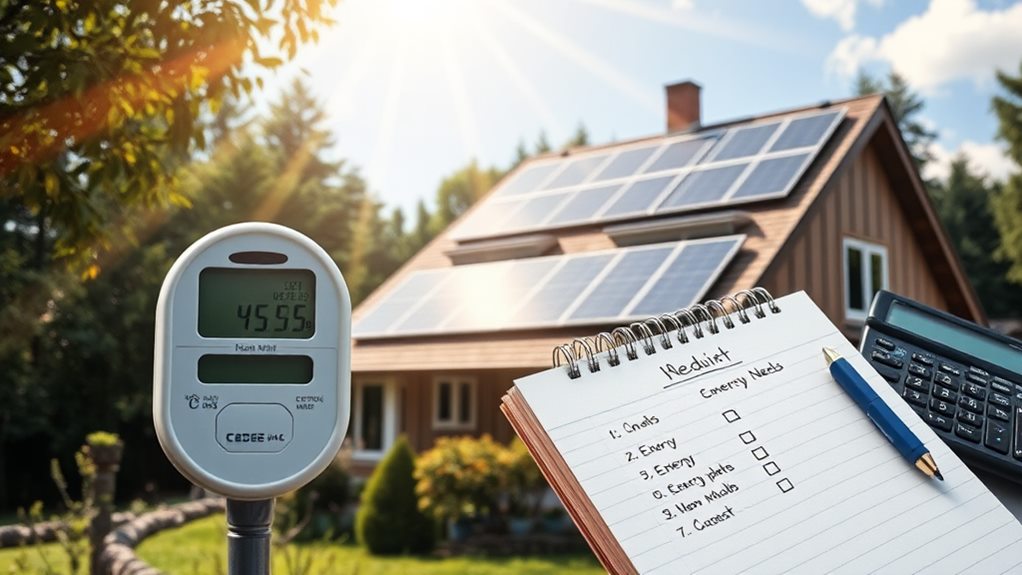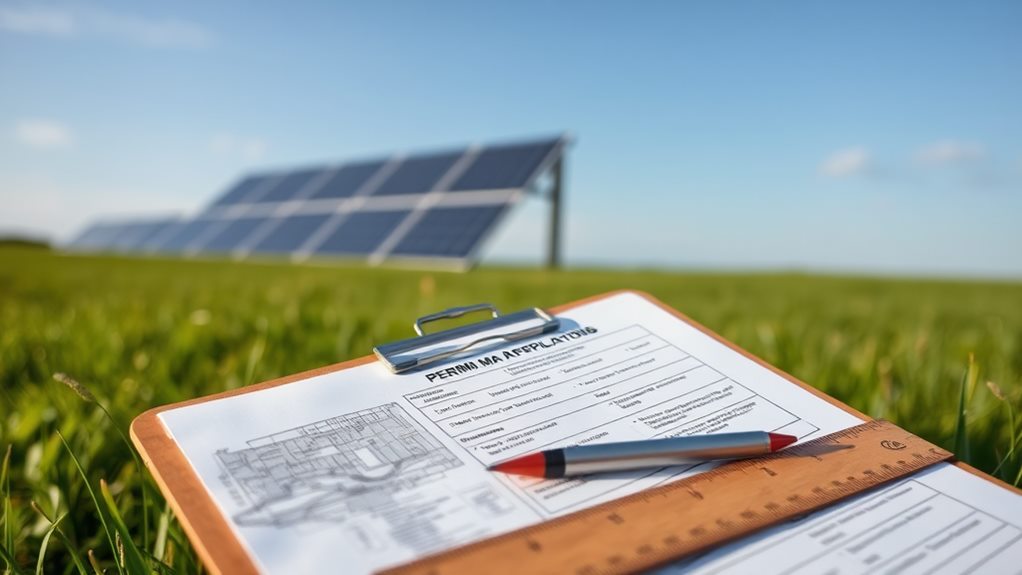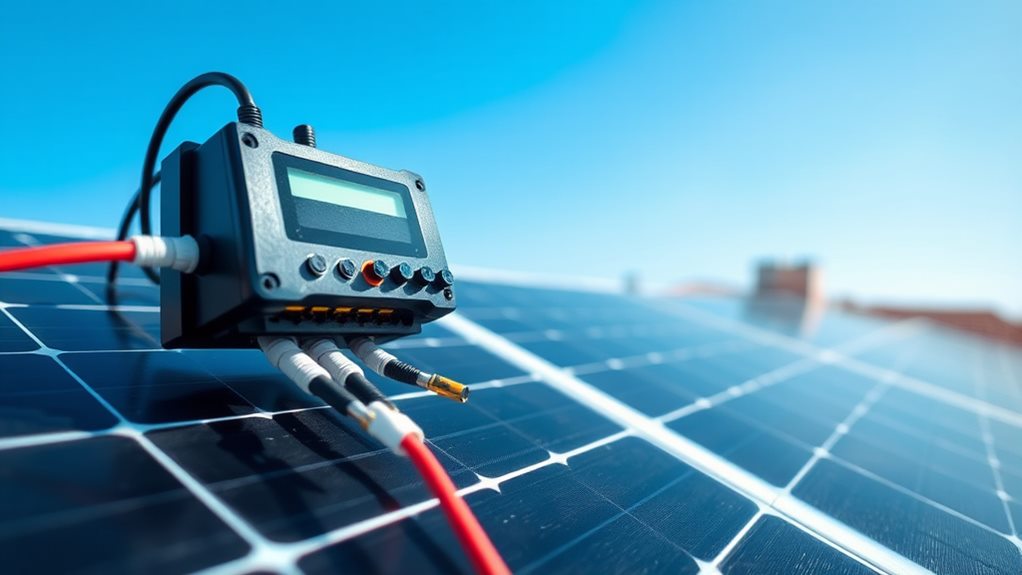To install solar panels easily, start by evaluating your energy needs, which involves conducting a home energy audit and reviewing your utility bills to understand consumption patterns. Next, plan your installation by assessing your roof's suitability and consulting local experts. After this, secure the necessary permits from local authorities to guarantee compliance with regulations. Then, execute the installation by mounting the panels and connecting them to an inverter. Finally, connect and monitor the system to track energy production. Following these steps carefully will facilitate a successful installation, and you'll discover more beneficial insights as you proceed.
Assess Your Energy Needs

Evaluating your energy needs is essential before installing solar panels. Start by conducting a home energy audit to assess your current consumption. This audit will help you determine the appropriate size and capacity of the solar energy system required to meet your demands effectively.
Additionally, take into account any available solar energy incentives that can aid in financing your system. Review past utility bills to identify peak usage times and the total kilowatt-hours consumed, as this information provides a clearer picture of your energy needs.
Don't forget to think about future energy requirements, such as planned home expansions or the addition of electric vehicles, to guarantee your solar panel system can accommodate potential increases in consumption.
Utilize online solar panel calculators to estimate the number of panels you'll need based on your energy usage and the average production capacity of available solar panels.
Plan Your Installation
Once you've assessed your energy needs, it's time to plan your installation. Start by evaluating your roof's suitability for a solar panel system. Check for adequate surface area, sun exposure, and any potential shading from nearby trees or buildings. This assessment is vital, as it directly impacts the efficiency of your solar installation.
Additionally, consider reaching out to a local expert for guidance, as the best solar energy systems team in Woodland Hills CA can provide personalized recommendations tailored to your situation.
Next, conduct a home energy audit to determine the specific energy requirements for your household. This audit helps you size the solar system appropriately, guaranteeing it meets your needs without excess capacity.
Research any available state and federal solar incentives, such as the Federal Investment Tax Credit (ITC). These financial incentives can greatly reduce your upfront costs and make solar installation more affordable.
Additionally, timing your installation is important. Aim to schedule the installation during favorable weather conditions, ideally in spring or summer. Good weather not only enhances safety but also guarantees a more efficient installation process.
Secure Necessary Permits

Before you start installing solar panels, it's vital to secure the necessary permits from local authorities. The specific permits required can vary considerably by location, so it's important to check with these authorities to identify what you'll need.
Many regions mandate both a building permit and electrical permits, which may involve different applications and approval processes. Additionally, understanding local zoning laws and regulations, similar to those governing ADU regulations, can help streamline your permit acquisition process.
The permitting process can take time, so it's wise to apply for permits early to avoid delays in your installation schedule. Some solar installation companies, like Sunrun, can manage the permitting process on your behalf, which streamlines the experience for homeowners. This can save you both time and potential frustration.
Once you've obtained the approved permits, be sure to keep copies, as they might be required for future inspections or utility connections. Having these documents on hand will facilitate any necessary communication with local authorities or utility providers down the line.
Execute the Installation
Executing the installation of solar panels is an essential step that requires careful attention to detail. Start by securing the racking system to your roof according to manufacturer guidelines. Ascertain it's properly anchored to withstand wind and weather conditions.
If you're considering solar energy systems, remember that home solar panels offer a way to utilize abundant sunlight in Los Angeles.
Next, mount the solar panels onto the racking system, using clamps to secure them. Make sure they're aligned for ideal sunlight exposure, as this will considerably affect energy production.
After positioning the panels, connect them to each other and to a power inverter. This device converts the direct current (DC) generated by the solar panels into alternating current (AC) for your home.
Following this, wire the inverter to your home's electrical panel while adhering to local regulations and confirming proper grounding to prevent electrical hazards.
Lastly, don't forget to schedule a city inspection. This step verifies compliance with local regulations and guarantees everything is up to code.
Once you pass the inspection, you'll be ready to connect your solar system to the utility grid, paving the way for sustainable energy production in your home.
Always prioritize safety precautions throughout this process to protect yourself and secure a successful installation.
Connect and Monitor System

After successfully installing the solar panels and completing the necessary wiring, it's time to connect and monitor your system. Begin by securely wiring the solar panels to the inverter, which converts the direct current (DC) generated by the panels into alternating current (AC) suitable for home use.
Once the inverter is connected, wire it to your electrical panel. Confirm compliance with local electrical codes to facilitate safe energy distribution throughout your home.
Next, install a monitoring system that tracks energy production and system performance in real-time. This allows you to promptly identify any operational issues. Regularly check the monitoring system for alerts regarding drops in energy production, as these could indicate potential malfunctions or maintenance needs.
To simplify monitoring, utilize a smartphone app or web portal provided by the monitoring service. This will grant you convenient access to performance data, energy savings, and system health updates.
Final Thoughts
By following these five steps, you can successfully install solar panels and harness renewable energy for your home. Curiously, studies show that homeowners can save an average of $1,500 annually on their electricity bills by switching to solar power. This not only reduces your carbon footprint but also enhances your energy independence. As you commence on this journey, remember that careful planning and execution are key to reaping the full benefits of solar energy.


Recent Comments